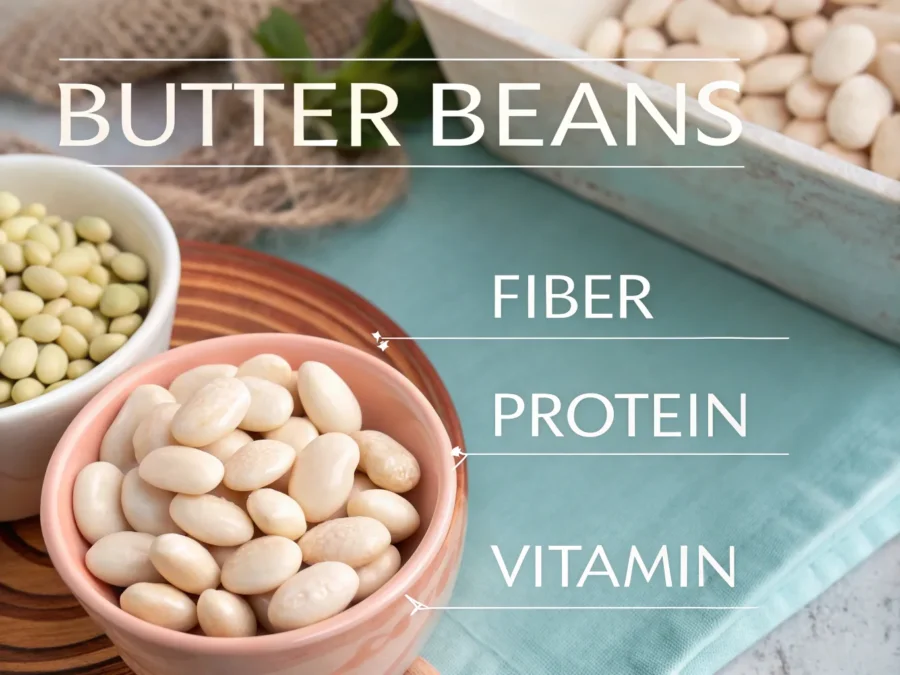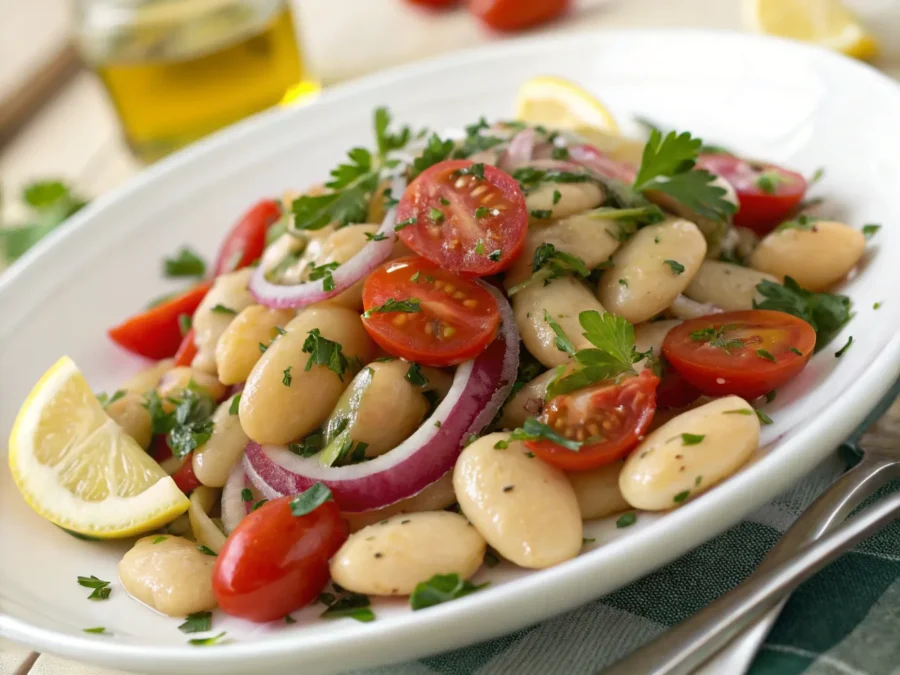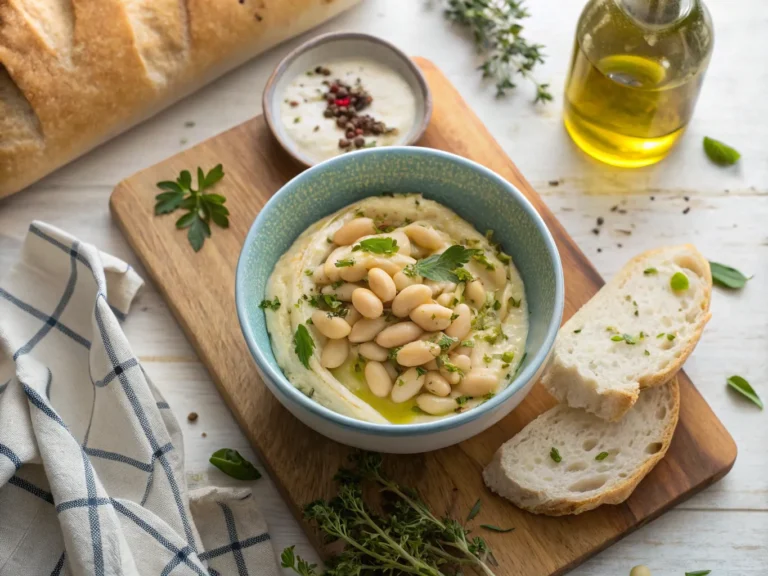Butter beans, also known as lima beans, are often overlooked but pack a nutritional punch. Whether you’re a health enthusiast or just curious about adding variety to your meals, these creamy legumes can be a game-changer. They are rich in essential nutrients, versatile in the kitchen, and known for their numerous health benefits. In this article, we’ll explore what butter beans are good for, from supporting heart health to providing plant-based protein, while also delving into their culinary uses and comparisons with other beans. Let’s dive in!
Table of Contents
Nutritional Profile
Butter beans are more than just a pantry staple; they’re a nutritional powerhouse. Packed with fiber, vitamins, and minerals, they can elevate your diet while offering various health benefits. Let’s take a closer look at what’s inside these legumes.
Key Nutrients in Butter Beans
Butter beans are brimming with essential nutrients. They’re an excellent source of plant-based protein, making them a go-to choice for vegans and vegetarians. A typical serving (about 1 cup cooked) provides approximately:
- 15 grams of protein
- 13 grams of dietary fiber
- 200 calories
These beans are also low in fat, making them a heart-healthy option.
Calories and Macronutrient Breakdown
Butter beans boast a balanced macronutrient profile, offering slow-digesting carbohydrates that keep you full and energized. With around 40 grams of carbs per cup, they provide a steady source of energy without spiking blood sugar levels, thanks to their low glycemic index.
Vitamins and Minerals in Butter Beans
These legumes are rich in vitamins and minerals essential for overall health, including:
- Iron: Supports red blood cell production and combats fatigue.
- Folate: Critical for DNA synthesis and ideal for expectant mothers.
- Magnesium: Maintains muscle and nerve function.
- Potassium: Helps regulate blood pressure.
Additionally, butter beans are a rare source of molybdenum, a trace mineral that supports detoxification. They also provide small amounts of zinc, manganese, and vitamin K, all of which are vital for bone health and immunity.
Health Benefits
Butter beans, often a hidden gem in the legume family, are an incredible source of nutrients that positively impact various aspects of health. Here’s an in-depth look at what butter beans are good for in promoting wellness.
Supporting Cardiovascular Health
Butter beans are excellent for heart health due to their high soluble fiber content. Soluble fiber binds to cholesterol in the digestive system, reducing its absorption and thereby lowering bad cholesterol levels. Additionally, they contain potassium, which helps regulate blood pressure by counteracting sodium’s effects. The presence of magnesium in butter beans ensures smooth heart rhythms, preventing irregularities and strain on the heart. These nutrients together make butter beans an essential addition to a heart-healthy diet.

Regulating Blood Sugar Levels
For those managing blood sugar levels, butter beans are a fantastic choice. Their low glycemic index ensures a slow release of glucose into the bloodstream. Moreover, their high fiber content slows digestion, preventing spikes in blood sugar after meals. This makes them particularly beneficial for people with diabetes or those seeking to maintain steady energy levels throughout the day.
Improving Digestive Health Through Fiber
Butter beans are rich in both soluble and insoluble fiber, which support gut health. Insoluble fiber helps maintain regular bowel movements by adding bulk to stool, while soluble fiber nourishes the beneficial bacteria in the gut. This dual action promotes a balanced gut microbiome and reduces the risk of digestive disorders such as constipation and irritable bowel syndrome (IBS).
Boosting Energy Levels with Iron
Iron is a key mineral in butter beans, playing a vital role in energy production. By aiding in the formation of red blood cells, iron ensures efficient oxygen transport throughout the body. This can help combat fatigue, particularly for individuals with iron-deficiency anemia. For vegetarians and vegans, butter beans provide a plant-based source of this essential mineral.
Strengthening Bones with Calcium and Manganese
Promoting Brain and Cognitive Function
Butter beans contain thiamine (vitamin B1), which is essential for brain health. Thiamine supports cognitive functions by aiding in the production of neurotransmitters like acetylcholine, crucial for memory and learning. Additionally, the vitamin K found in butter beans supports nerve function and protects the brain from oxidative stress.
For more health-boosting recipes featuring nutrient-rich ingredients, you might enjoy this guide on chicken and bean soup, which pairs beautifully with butter beans.
Culinary Uses
When it comes to versatility, butter beans shine in a wide array of dishes, making them a staple for many cuisines. Let’s explore how to incorporate them into your meals effectively.
Popular Recipes Featuring Butter Beans

Butter beans are beloved for their creamy texture, which makes them an ideal addition to soups, stews, and casseroles. They can also be mashed or pureed to create spreads and dips. One popular dish is a Mediterranean butter bean salad, where they are tossed with olive oil, lemon, and fresh herbs for a refreshing side. You can also add them to vegan curries for extra protein and creaminess.
Pairing Butter Beans with Other Ingredients
Butter beans complement a variety of ingredients, from leafy greens to robust spices. For a hearty, comforting meal, pair them with root vegetables and smoked paprika. They also go well with tomatoes, garlic, and olive oil in a classic Italian-inspired stew. For a plant-based protein boost, try combining butter beans with quinoa or farro in a grain bowl.
Using Butter Beans in Vegan and Vegetarian Diets
As a rich source of protein and fiber, butter beans are a must-have in vegan and vegetarian diets. They are an excellent meat alternative in dishes like chili or shepherd’s pie. Furthermore, their creamy consistency can replicate dairy in vegan recipes such as butter bean-based alfredo sauce or dips like hummus.
By incorporating butter beans into your meals, you’re not just adding flavor and texture but also reaping significant health benefits. They’re a culinary star that deserves a spot in every kitchen!
Comparing Butter Beans to Other Beans
Butter beans are often compared to other types of beans due to their similar uses in recipes. However, they have distinct qualities that set them apart. Understanding these differences can help you choose the best bean for your meals and answer the question, What are butter beans good for?
Are Lima Beans and Butter Beans the Same Thing?
Yes, lima beans and butter beans are the same bean but referred to differently based on region. In the United States, the term “butter beans” often refers to the larger, mature version of lima beans, known for their creamy texture and mild flavor. This versatility makes them ideal for dishes like stews and casseroles. However, younger lima beans tend to be smaller and firmer, often used in salads or succotash.
Difference Between Butter Beans and Cannellini Beans
Although butter beans and cannellini beans are both white beans, they differ in taste, texture, and culinary uses. Butter beans are softer and creamier, while cannellini beans are firmer and have an earthier flavor. Cannellini beans are common in Italian dishes, especially soups like minestrone, whereas butter beans excel in creamy dishes or as a standalone side.
How Butter Beans Compare to Pinto Beans
Butter beans and pinto beans differ significantly in flavor and appearance. Pinto beans are speckled and have a nuttier taste, making them ideal for Mexican dishes such as refried beans or chili. Butter beans, on the other hand, are smoother and creamier, better suited for comfort foods like casseroles or mashed side dishes.
How to Incorporate Butter Beans Into Your Diet
Adding butter beans to your meals is simple, and their versatility ensures they can fit into almost any dish. Here’s how you can start enjoying the benefits of this nutritious legume.
Tips for Cooking Butter Beans
Cooking butter beans from scratch ensures you can control the texture and flavor. Start by soaking dried beans overnight, which reduces cooking time and improves digestibility. Cook them in a pot of boiling water with a pinch of salt until tender, typically 45–60 minutes. To enhance flavor, add aromatics like garlic, bay leaves, or thyme during cooking.
If you’re short on time, canned butter beans are a convenient option. Simply rinse them to remove excess sodium before using.
Storage and Preparation Techniques
Butter beans can be stored in the refrigerator for up to five days after cooking, making them ideal for meal prep. Freeze leftovers in airtight containers for up to three months to reduce waste and ensure you always have a protein-rich ingredient on hand.
Daily Portions and Serving Suggestions
To maximize their health benefits, aim to include butter beans in your diet a few times per week. A typical serving size is about one cup, which provides a substantial dose of protein, fiber, and key vitamins. Use them in soups, salads, or grain bowls for a satisfying and nutrient-rich meal. Butter beans are also a great base for dips or spreads, such as a butter bean hummus, for a unique twist on a classic.
Butter beans are an easy and delicious way to elevate your meals while reaping their impressive health benefits. Start experimenting with them today to discover all the ways they can transform your dishes!
FAQs About Butter Beans
Butter beans, with their creamy texture and rich nutritional profile, often raise questions about their uses and comparisons to other beans. Below, we answer some frequently asked questions to help you understand what are butter beans good for and how to include them in your meals.
Are Lima Beans and Butter Beans the Same Thing?
Yes, lima beans and butter beans are essentially the same. The name “butter beans” typically refers to the mature, larger variety of lima beans, prized for their creamy consistency when cooked. They are perfect for hearty dishes like casseroles or stews.
Are Cannellini Beans and Butter Beans the Same?
No, butter beans and cannellini beans are not the same. While both are white beans, butter beans have a softer, creamier texture, making them ideal for purees or creamy dishes. Cannellini beans, on the other hand, are firmer and better suited for Italian-inspired soups and salads.
Are Butter Beans and Pinto Beans the Same?
No, butter beans and pinto beans differ in taste, appearance, and use. Pinto beans are speckled and nutty, perfect for Mexican cuisine, while butter beans are smooth and mild, ideal for comfort foods like mashed sides or creamy dishes.
How Do Butter Beans Benefit Vegetarians?
Butter beans are an excellent protein source for vegetarians. Their high fiber, vitamins, and minerals also support a balanced, plant-based diet, answering the question, What are butter beans good for? perfectly.
Conclusion
Butter beans are more than just a simple legume they’re a nutritional powerhouse that can transform your meals and health. Rich in protein, fiber, and essential nutrients like iron, magnesium, and folate, they support heart health, brain function, and digestion. But what truly sets them apart is their versatility in the kitchen.
From hearty stews to light salads, butter beans shine in a variety of dishes. They can replace meat as a plant-based protein in vegetarian diets or add creamy texture to soups and dips. Their mild flavor allows them to adapt to countless recipes, answering the age-old question, What are butter beans good for?, with a resounding “everything!”
Butter beans also stand out when compared to other beans. Their creamy texture distinguishes them from firmer beans like cannellini or nutty ones like pinto beans. They’re a staple for anyone looking to enjoy both taste and health benefits in one bite.
As we’ve explored in this article, incorporating butter beans into your meals is easy and rewarding. Whether you’re looking for a nutrient-rich side dish, a hearty soup ingredient, or a protein-packed addition to a vegan recipe, butter beans are up for the task. Their high fiber content keeps you feeling full, while their iron and magnesium help boost energy levels.

